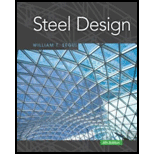
Steel Design (Activate Learning with these NEW titles from Engineering!)
6th Edition
ISBN: 9781337094740
Author: Segui, William T.
Publisher: Cengage Learning
expand_more
expand_more
format_list_bulleted
Question
Chapter 4, Problem 4.3.6P
To determine
(a)
The design strength for LRFD and allowable strength for ASD.
To determine
(b)
The design strength for LRFD and allowable strength for ASD.
Expert Solution & Answer
Trending nowThis is a popular solution!

Students have asked these similar questions
Read the question carefully and give me right solution according to the question.
A W12x79 of A573 Grade 60 (Fy=415 MPa) steel is used as a compression member. It is 8 m long, pinned at the top fixed at the bottom, and has additional support in the weak direction at mid-height. Properties of the section are as follows:
A = 14,500 mm^2
Ix = 258.6 x 10^6 mm^4
Iy = 84.375 x 10^6 mm^4
Calculate the effective slenderness ratio with respect to strong axis buckling using theoretical value of k.
2. The beam shown in Figure P5.8-3 is a W16 × 31 of A992 steel and has continuous lateral support. The two concentrated loads are service live loads. Neglect the weight of the beam and determine whether the beam is adequate for flexure and shear.
a. Use LRFD. b. Use ASD.
1. An unsymmetrical flexural member consists of a 70 × 600 top
flange, a 70 x 400 bottom flange, and a 12 × 180 web.
a, Determine the Section Modulus.
b. Determine the distance from the bottom of the shape to the horizontal
plastic neutral axis. ( Take note: Bottom Distance i need, not the top distance)
c. If A572 Grade 50 steel is used, what is the plastic moment MPy for
the horizontal plastic neutral axis?
Chapter 4 Solutions
Steel Design (Activate Learning with these NEW titles from Engineering!)
Ch. 4 - Prob. 4.3.1PCh. 4 - Prob. 4.3.2PCh. 4 - Prob. 4.3.3PCh. 4 - Prob. 4.3.4PCh. 4 - Prob. 4.3.5PCh. 4 - Prob. 4.3.6PCh. 4 - Prob. 4.3.7PCh. 4 - Prob. 4.3.8PCh. 4 - Prob. 4.4.1PCh. 4 - Prob. 4.4.2P
Ch. 4 - Prob. 4.6.1PCh. 4 - Prob. 4.6.2PCh. 4 - Prob. 4.6.3PCh. 4 - Prob. 4.6.4PCh. 4 - Prob. 4.6.5PCh. 4 - Prob. 4.6.6PCh. 4 - Prob. 4.6.7PCh. 4 - Prob. 4.6.8PCh. 4 - Prob. 4.6.9PCh. 4 - Prob. 4.7.1PCh. 4 - Prob. 4.7.2PCh. 4 - Prob. 4.7.3PCh. 4 - Use A992 steel and select a W14 shape for an...Ch. 4 - Prob. 4.7.5PCh. 4 - Prob. 4.7.6PCh. 4 - Prob. 4.7.7PCh. 4 - The frame shown in Figure P4.7-8 is unbraced, and...Ch. 4 - Prob. 4.7.9PCh. 4 - Prob. 4.7.10PCh. 4 - Prob. 4.7.11PCh. 4 - Prob. 4.7.12PCh. 4 - Prob. 4.7.13PCh. 4 - Prob. 4.7.14PCh. 4 - Prob. 4.8.1PCh. 4 - Prob. 4.8.2PCh. 4 - Prob. 4.8.3PCh. 4 - Prob. 4.8.4PCh. 4 - Prob. 4.9.1PCh. 4 - Prob. 4.9.2PCh. 4 - Prob. 4.9.3PCh. 4 - Prob. 4.9.4PCh. 4 - Prob. 4.9.5PCh. 4 - Prob. 4.9.6PCh. 4 - Prob. 4.9.7PCh. 4 - Prob. 4.9.8PCh. 4 - Prob. 4.9.9PCh. 4 - Prob. 4.9.10PCh. 4 - Prob. 4.9.11PCh. 4 - Prob. 4.9.12P
Knowledge Booster
Recommended textbooks for you
 Steel Design (Activate Learning with these NEW ti...Civil EngineeringISBN:9781337094740Author:Segui, William T.Publisher:Cengage Learning
Steel Design (Activate Learning with these NEW ti...Civil EngineeringISBN:9781337094740Author:Segui, William T.Publisher:Cengage Learning

Steel Design (Activate Learning with these NEW ti...
Civil Engineering
ISBN:9781337094740
Author:Segui, William T.
Publisher:Cengage Learning